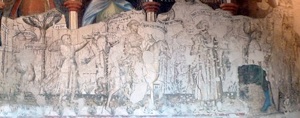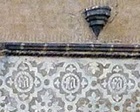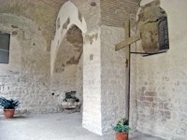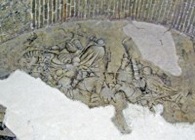Paolo de Nuocchoro (Paolo Nocchi) was enrolled in the Corporazione dei Maestri di Legname (woodworkers’ guild) in Foligno in 1404. He is subsequently documented on a number of occasions, described as a painter. He was the son of the painter Vagnozzoro (Noccuro) Meccastra (died after 1388), and the uncle of Pierantonio Mezzastris.
No securely attributed works by Paolo Nocchi are known.
Foligno
Palazzo Trinci
Frescoes by the Workshop of Gentile da Fabriano (1411-2)
Paolo Nocchi came to the attention of scholars in 2000, when a book of handwritten notes was found in a private archive in Foligno in which the scholar Lodovico Coltellini seems to have documented some of the frescoes of Palazzo Trinci in 1780. In particular, he had apparently seen two receipts in a chest in the “camera delle udienze” of the papal governor for payments that Ugolino III Trinci had made in August 1411 and in January 1412 to Gentile da Fabriano for work on three rooms on the piano nobile of the palace. This suggested that tUgolino III Trinci had commissioned the work soon after the palace was built: an inscription gives the construction period as 1389-1407, although other documents suggest that the work actually continued until 1411.
The status of the material attributed to Lodovico Coltellini is equivocal, and some scholars doubt that Gentile da Fabriano was associated with the work. However, Ugolino Trinci had family ties with Chiavello Chiavelli, the ruler of Fabriano, and this could well explain such a commission. Many scholars reject the attribution on stylistic grounds, arguing that, if Gentile da Fabriano were indeed involved, the frescoes must have been largely executed by his workshop. The first of the newly-discovered documents included the names of some of his collaborators:
-
✴Jacobo da Venezia, possibly the young Jacopo Bellini;
-
✴Francesco di Giambono da Bologna, who was described as resident in Foligno;
-
✴Battista di Domenico da Padova, who was documented again in Foligno in 1417 and 1426; and
-
✴Paolo Nocchi, the only locally-born artist mentioned.
It seems likely that other artists were also involved in the project.
The three rooms mentioned in the documents were:
-
✴the loggia;
-
✴the Sala delle Rose (also called the Sala delle Stelle or delle Arti e dei Pianeti); and
-
✴the Sala dei Giganti (also called the Sala degli Imperatori).
Most of the frescoes in the corridor from Palazzo Trinci to the Duomo are also usually attributed to this group of artists.
Seven ages of man (ca. 1407)

The remnants of this cycle of nearly-monochrome frescoes were discovered beneath the later frescoes (see above) on the left wall of the corridor on the piano nobile that links the palace to the Duomo. Since the corridor was built in ca. 1407 and the later frescoes were executed by Gentile da Fabriano and his workshop in 1411-12, and since the subject of the over-painted frescoes was repeated on the opposite wall in the later frescoes, it is clear that the initial plans were modified in favour of a more ambitious programme at an early stage.
This consideration led Francesco Federico Mancini (referenced below) to suggest that Paolo Nocchi, the only local artist to work under Gentile da Fabriano, might have been commissioned initially in his own right to decorate the corridor and then continued in a subordinate role under Gentile da Fabriano when more ambitious plans were put into effect. This is despite the fact that the earlier frescoes have traditionally been attributed on stylistic grounds to Giovanni di Corraduccio Mazzaforte.
Other Frescoes in Foligno
Two other nearly-monochrome fresco cycles in Foligno are generally accepted to be by the artist who painted the earlier frescoes in the corridor of Palazzo Trinci. All three cycles have traditionally been attributed on stylistic grounds to Giovanni di Corraduccio Mazzaforte. However, if Paolo Nocchi did indeed paint the frescoes in Palazzo Trinci, then the other two cycles should also be attributed to him. These two cycles are:
Frescoes in Palazzetto del Podestà (ca. 1407)

The so-called Palazzetto del Podestà, which became a Trinci residence in the 14th century, was linked by an overpass to Palazzo Trinci, probably at about the time that the latter was built. The frescoes of its upper loggia, which were probably all the work of the same artist, seem to have formed part of the original programme devised for the decoration of Palazzo Trinci:
-
✴The (nearly) monochrome frescoes on the interior walls, which were discovered in 1986 (illustrated in the paper by Francesco Federico Mancini referenced below), are very similar to frescoes (ca. 1407) that Ugolino III Trinci commissioned for the corridor that links Palazzo Trinci to the Duomo. Mancini deduces that one fresco probably illustrate the mythical founding of Foligno after the burning of Troy, while the other scenes demonstrate the virtues and legitimacy of the Trinci family.
-
✴The frescoes on the exterior facade, above the windows of the loggia (illustrated above), which represent the Cardinal Virtues, reinforce this theme.
-
✴The device “fa” on the frescoes on the middle register of the facade, which probably represents the motto “fides adiuvat” (faith helps), is also found extensively inside Palazzo Trinci.

Frescoes of Loggia del Paradiso, Abbazia di Sassovivo (early 15th century)


These damaged nearly-monochrome frescoes in the so-called Loggia del Paradiso of the Abbazia di Sassovivo are also very similar to frescoes (ca. 1407) that Ugolino III Trinci commissioned for the corridor that links Palazzo Trinci to the Duomo. They are almost certainly by the same artist, and were probably commissioned by Giacomo Trinci, a nephew of Ugolino III Trinci, who was abbot at Sassovivo in 1411-39.
Read more:
S. Felicetti, “Pittori Forestieri a Foligno nel Primo Quattrocentro: Regesto Documentario”, p 115 and Documents: 4; 5; 9; 10; 13; 18; 20; 22; and 24
in A. Caleca and B. Toscana (Eds), “Nuovi Studi sulla Pittura Tardogotica: Palazzo Trinci”, (2009) Foligno.
F. Mancini, “La Loggia delle Virtù: Allegoria di un Governo Illuminato”,
in G. Benazzi and F. Mancini (Eds), “Il Palazzo Trinci di Foligno”, (2001) Perugia
The suggested attribution of the earlier frescoes in the corridor from Palazzo Trinci to the Duomo to Paolo Nocchi is on p 334.
Return to Art in: Foligno.



